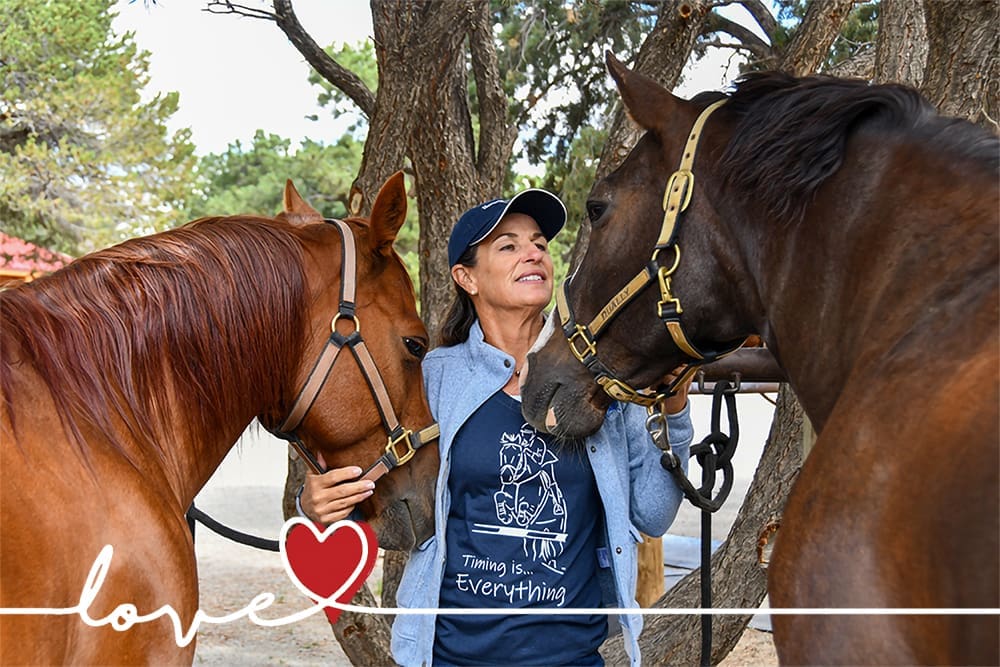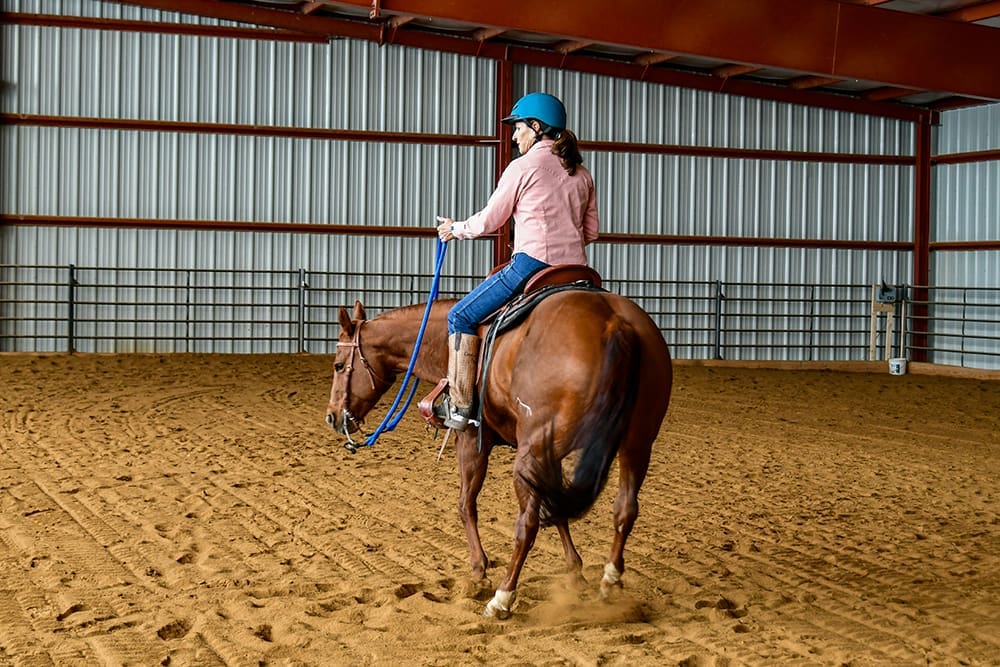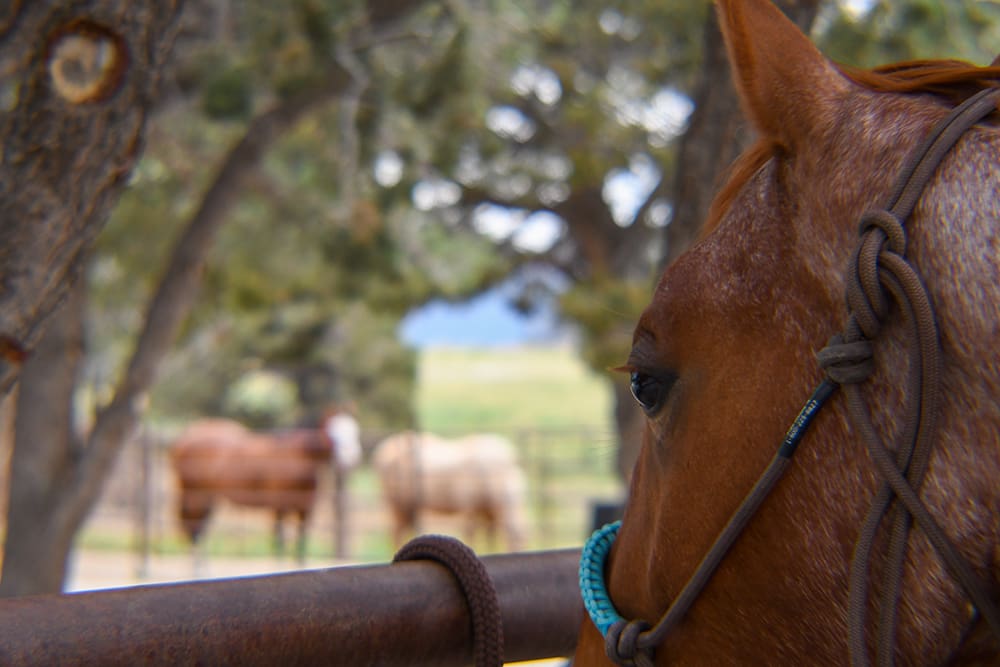To Buy or Not to Buy?
Do you have your eye on a stock-horse breed for your next surefooted trail horse? Follow top trainer/clinician Julie Goodnight’s seven expert horse-evaluation steps to help ensure a successful purchase.
By Heidi Melocco with Julie Goodnight
You’ve found your dream horse. He looks perfect from afar, but now it’s time to meet the horse to evaluate his suitability.
“When shopping for any horse, top factors to consider are training, temperament, experience, and conformation,” says top trainer/clinician Julie Goodnight.
As a trail rider and equestrian traveler, you also need a horse that will easily load into the trailer and travel calmly to your chosen destinations, Goodnight adds.
To help you make a purchase decision, Goodnight will walk you through seven horse-evaluation steps: (1) trust first impressions; (2) ask key questions; (3) evaluate conformation; (4) consider compatibility; (5) observe ground work; (6) go for a trial ride; and (7) make an offer.
In each of these steps, Goodnight will provide green flags and red flags in especially critical areas.
Are you getting the next generation saddled up, as well? Goodnight will also tell you what to look for in a kid’s first horse.
Step 1. Trust First Impressions
“Trust your first impressions about the horse and the seller,” says Goodnight. “Take note if anything doesn’t feel right or seems sketchy. It’s a big step to buy a new horse. You want to feel good about the process and your new trail partner.”
Here’s how to get the most out of your first impressions.
Environment. Start observing the minute you step onto the property. While there can be great horses in less-than-stellar conditions, the overall environment can provide clues about how the horses are cared for. If the place is neat and tidy, it’s a good bet that the horses have a regimented routine and health-care plan, as well. Green flag: Clean, orderly grounds, pastures, stalls, and barn. Red flag: Poor footing, murky pens, ill-kept structures, and barn hazards.
Horse. On your first approach, how does the horse react? Does he seem well cared for? Green flag: A clean, happy horse that lifts his head to greet you. Bonus points if he walks over to say hello. Red flag: An ill-groomed, poorly kept horse that hangs his head, seems depressed, turns tail, and ignores you.
Step 2. Ask Key Questions
As you inspect the environment and greet the horse, ask the seller the following key questions.
Why are you selling the horse? Listen closely to the answer. Green flag: The seller just doesn’t have time for the horse, has too many horses, or has new interests. These answers typically mean the horse just needs to find a new home. Red flag: The seller pauses, or seems to be covering up a health or behavior issue. Keep asking questions until you get at the truth.
What is the horse’s medical history? Ask specifically whether the horse has colicked. Colic is the number-one killer of horses. And horses that tend to colic tend to colic again. Ask also if the horse has taken time off for an injury; length of time can indicate severity. Green flag: The seller reports an unremarkable, colic-free, injury-free history. Red flag: Repeated colic issues, long periods of injury recovery, and signs of evasion.
Are medical records available? Ask to see the horse’s vaccination, deworming, and other medical records. If the seller is organized and has records available, you’ll have a sense of how the horse was treated. Green flag: The seller is open about the horse’s medical history. Red flag: No medical records are available or the records appear incomplete.
What’s the horse’s training history? Ask how the horse has been trained and how many days of professional training he’s had (for example, 30, 60, 90 days, or more). A well-trained horse is typically less costly in the long run than paying for training. Green flag: Any professional training. Professional trainers are typically consistent and clear, leading to a willing, responsive horse. Red flag: A horse that’s been ridden by one rider or has no professional training.
What’s the horse’s current job? Find out what the horse has been used for in the past. Green flag: Trail-riding experience is ideal. But note that if the horse has been shown, that means he’s an experienced traveler and has been exposed to a variety of sights and sounds. Red flag: The horse’s experience doesn’t dovetail with your needs in any way.
Step 3: Evaluate Conformation
You might have fallen in love with your prospective horse via photos on paper or onscreen. Now is the time to step back and consider the horse through an objective lens.
Conformation is one thing you can’t change, so let’s take a closer look at this key consideration.
Balance. To determine balance, stand at the horse’s side and mentally draw lines from nose to withers, withers to croup, and croup to tail. These three sections should be as equal as possible. Then look at the horse’s shoulder angle. A horse with a straight shoulder may provide a bouncy ride.
Back. An optimal back length makes for a strong trail horse, especially on steep hills. Ideally, the horse’s topline (from base of withers to croup) should be half the length of his underline (from girth to stifle).
Hips. The length and turn of the horse’s hips are critical to his athletic ability. In general, larger hips provide more power to propel the horse forward. Each hip should be about the same length as the back. Hip slope should roughly match shoulder slope.
Legs. Look for a horse with straight legs, but note that few horses are perfect. A little crookedness can be acceptable. Consider how high in the leg any crooked angles appear. Green flag: The horse toes in a little bit. Red flag: The horse is crooked in the knees or hocks.
Hooves. Goodnight has found that black hooves are often tougher than white hooves, which can be more prone to stone bruises and chipped walls. Consider hoof quality. Ask to see the horse’s farrier records. Talk to the horse’s current farrier, if possible.
Overall conformation. Overall, weigh conformation pros and cons. If the horse has other favorable factors, but has, say, a slightly long back, that may be acceptable, considering your purpose and budget. But if the horse has too many red flags, move on. If the horse is well-conformed, determine whether he’s the right match for you, in terms of his age, temperament, and condition.
Age. Be wary of young horses unless you’re an experienced trainer. A young horse can seem well-trained, but he may not be consistent as he matures. He may need many more saddle hours to become the reliable trail partner you’re looking for. If you’re looking for a reliable mount, find a horse 8 years old or older.
Temperament. Choose a horse whose personality and temperament match your own. If you’re laid back, look for a mellow mount. If you love to be on the go, look for a spirited, but not spooky, animal. Tip: Through the ages, horsemen have found that a horse with large, wide-set eyes and a flat forehead is often kind and willing. A forehead bulge can mean the horse is more ornery. Green flag: A horse with a steady, kind, generous personality. Red flag: A spooky, nervous horse.
Condition. If the horse is out of shape, you’ll need to condition him for long rides and rough terrain. If the horse is very thin, it’ll also take time to get him in top form. Consider how much time and patience you’ll have for this process. Green flag: A fit horse that looks like he can tackle the trails. Red flag: An obese horse that may have insulin resistance or a history of founder. Only a veterinarian can rule out these lingering effects.
Step 5. Observe Ground Work
You can tell a lot about a horse’s behavior, temperament, and training even before he’s saddled up. Here’s how to evaluate a horse on the ground.
Handler clues. The moment you drive up, watch the handler for clues to the horse’s basic behavior. Green flag: The handler invites you to watch as the horse is collected from the pasture or stall. Red flag: When you drive up, the horse is already tacked up and sweaty; this can mean the handler has worked off the horse’s excess energy for a calmer ride.
Ground manners. Watch the horse as he’s caught, led, groomed, saddled, and bridled. Observe the horse’s reactions to handler cues and willingness to stand still. Pay attention to how the horse reacts when the handler cleans the hooves. Ask the handler to tie the horse. Green flag: A horse that’s well-mannered on the ground and stands calmly when tied. Red flag: A horse that resists being handled, and is put in crossties or is fidgety when tied. This behavior can be difficult to fix
Tacking-up clues. Watch how the horse reacts when he’s saddled and cinched. If he pins his ears or fidgets, he could have back pain or saddling issues. Before the saddle pad is on, note any white marks on the horse’s back — white hairs from saddle rub are a signal that the horse has had saddle-fit issues that could have led to soreness.
Trailer-loading ease. Ask the handler to show you how the horse loads in the trailer. As you watch the process, note that it may not be a red flag if the horse doesn’t load easily, especially if the handler’s body position or loading style stopped the horse from going in. If you feel you’d do anything differently, ask to work with the horse yourself.
Step 6. Go for a Trial Ride
The horse is tacked up and you’re ready to go for a ride. As you prepare to ride him, and while in the saddle, follow these guidelines.
Be cautious. “Never get on a strange horse that the owner isn’t willing to ride,” Goodnight advises. “It could be okay, but the seller could be scared of the horse. Gather more information before you mount up.” Be sure to wear an ASTM-approved, SEI-certified helmet and sturdy boots.
Watch another rider. Ask to watch someone else ride the horse, first. Is the rider relaxed and riding with a loose rein? Or is the rider gripping on the reins and looking tense? If the rider is tense, how is the horse reacting? Notice the rider’s habits and decide what you’d do differently. Green flag: A horse that shows patience when a rider grips and pulls on his mouth. Red flag: A horse that reacts poorly to a tense rider, creating an escalating cycle of harsher cues and increased tension. Decide whether it’s safe for you to ride such a horse.
Stay close. When you first mount up, stay close to the barn, or ride in an arena, until you feel comfortable on him.
Become a passive rider. After you’ve ridden the horse a bit, find out what happens if you become a passive rider — that is, relax the reins, and still your seat and leg cues. Green flag: He continues in the direction you’ve asked of him. Red flag: He moves off on his own or pulls to the gate.
Become an active rider. Switch styles, and become an active rider — that is, pick up the reins (while being gentle on his mouth), and cue him with your seat and legs. Ask him to turn left and right; ride him as though he were yours. Is he responsive and willing?
Ride off. After you’ve tested the horse in a safe environment, find out how he acts when you ride off by yourself. You won’t have to go far to find out whether he’s barn sour or skittish on the trail.
Go back to the barn. If you’re at all concerned about the seller’s honesty — or if the horse was saddled and ready for you to ride — stop by unannounced to find out whether the horse seems the same as he was on your first visit. Ask the seller if you can catch, groom, saddle, and ride the horse as though he were yours.
Step 7. Make an Offer
If the horse meets all your criteria and you think he’s a good match for you, take action right away. Good horses usually don’t last long on the market.
Ask for a trial period, but note that if the seller says no, that’s not necessarily a red flag, according to Goodnight.
“It’s often a liability issue to allow someone else to handle a horse when the owner can’t be present,” she notes. “And if the owner knows he has a good horse, he knows others will be eager to make an offer.”
After you make an offer, but before the sale is considered final, make an appointment for a prepurchase veterinary examination with an objective veterinarian in the area. Book your own appointment, and be present for the exam. Obtain any needed documents before you hand over a check.
Trust your instincts, and act fast when it feels right.
JUST FOR KIDS
7 First-Horse Tips
Here are seven things to consider when shopping for a kid’s first horse or pony, according to top trainer/clinician Julie Goodnight.
Consider age. Older is better. The Rule of 20 says that the age of the horse plus the age of the rider must equal at least 20. Often, you can find a well-trained, experienced horse best suited to a child (and also reasonably priced) in the 18- to 22-year-old bracket.
Consider experience. Look for a horse that’s set in his ways, experienced, unflappable, and used a lot. You want a horse that’s done many different things and worked hard for a living. This horse will be a solid citizen and won’t want to work any harder than he has to. If he’s traveled frequently, all the better. There’s probably nothing that will surprise this horse.
Consider temperament. Babysitter wanted! Look for a temperament of solid gold — a horse that’s calm, friendly, and willing, with an eagerness to please and a cautious approach. Ideally, find a thinking horse that will act as a supervisor when you’re not present. Look for a big, kind eye, a flat forehead, and a calm awareness.
Consider size. Find a horse or pony that’s the right size for the child. If the youngster can brush, clean feet, and saddle up all by herself, she’ll learn to be an independent rider.
Disregard discipline. Don’t worry about the job the horse has done up until now. Emphasize safety and fun. A well-trained, experienced horse from any discipline will fit this bill.
Don’t get cheap. Spend as much as you can to get the best, safest horse possible. Look up the cost of one trip to the emergency room. Add this amount to whatever you were planning to spend on the horse to help ensure a trustworthy, reliable mount.
Save your pennies. If the child is seriously smitten, her first horse won’t be the last. Kids outgrow their first horse after a couple years — not so much in size, but in performance. The child’s second horse may be more expensive as the budding rider moves into more advanced activities.



